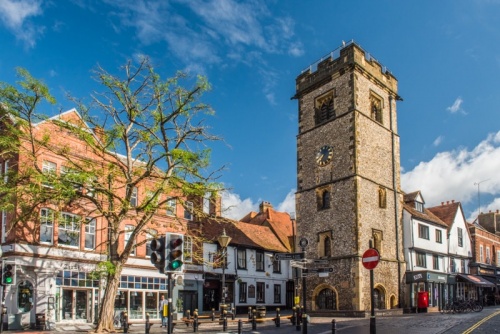
In the historic market place of St Albans, a stone's throw from the cathedral precinct, stands a unique medieval survivor; the Clock Tower, built between 1403 and 1412 (update: recent dendrochronology testing has determined that the tower was built in 1405). This is the only known example of a free-standing medieval town belfry in England.
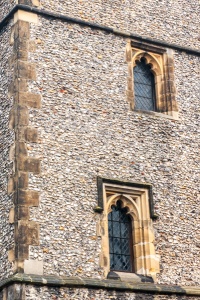
Right from the start, the tower had a mechanical clock, which would have been a very rare and expensive piece of machinery at the time. But why, since the nearby Abbey had a similar clock, did the town feel the need to build another?
The answer probably lies in a great rivalry between the wealthy merchants of the town and the powerful abbot of St Albans. The civic authorities wanted to establish their own authority, and so the Clock Tower was built as a conscious effort to thumb their noses at the abbot.
The tower served several purposes; since it had a clock, it naturally could be used to tell time, but also to ring the curfew bell to indicate when people had to retreat indoors for the night. The tower was also used as a lookout post; a sort of early warning system for approaching trouble, and to give the alarm if a fire broke out.
A curfew bell, cast in 1335 and weighing a tonne, still hangs inside the belfry chamber, reached by a narrow flight of 93 steps. The bell was rung to give the alarm before the first Battle of St Albans in 1455, one of the bloodiest battles of the Wars of the Roses.
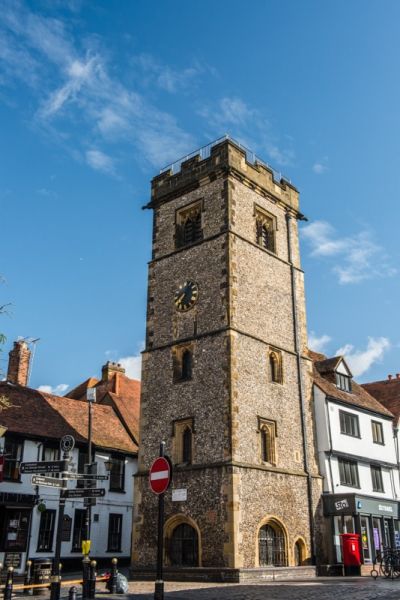
During the Napoleonic Wars, the tower gained yet another function when the Admiralty used it as a semaphore station, relaying messages to and from Yarmouth on the coast. The signalling system was so efficient that it took just 5 minutes to exchange messages with Yarmouth, a distance of approximately 220 miles. The St Albans signalling station was one of 16 linking the Admiralty offices in Whitehall, London, with the North Sea Fleet command at Great Yarmouth.
From 1837 the tower and the adjacent building were used as a beerhouse by a pair of local brewers.
The tower was not maintained after the war and by the 1860s it was threatened with demolition. Instead, Sir Gilbert Scott was brought in to oversee the restoration, and subsequent restoration work in the 21st century has kept it in reasonable condition.
There are 5 floors within the tower; the bottom floor was let as a shop premises, with the shopkeeper's residence above. The second floor was where the clock keeper and his family lived from 1412-1866.
On the 3rd floor is the large Victorian clock that replaced the earlier mechanism when the tower was restored in 1866. The clock was designed by Lord Grimthorpe, who also designed the mechanism for the clock tower of the Houses of Parliament (erroneously called Big Ben, which is actually the hour bell). The original 14th-century bell hangs on the 4th floor, as it has done for some 700 years. Then there is the roof, where the Napoleonic shutter telegraph was used.
The tower stands near Waxhouse Gate entrance to the medieval Abbey of St Albans. Here, in 1290, the funeral procession of Queen Eleanor, wife of Edward I, rested on its journey to London. The grieving King Edward erected a memorial cross at each place the procession stopped while bringing the queen for burial at Westminster Abbey.
For centuries the St Albans 'Eleanor Cross' stood outside the Abbey entrance, but in 1703 the town government, in their infinite wisdom, pulled down the cross and replaced it with a town pump. The pump, in turn, was replaced by a water fountain in 1874. The water fountain was later moved, so the only reminder of the Eleanor Cross is a small plaque on the side of the Clock Tower.
Another plaque, near the first, reminds us that the French Row of buildings immediately beside the tower was occupied by troops of the French Dauphin in 1216, during the Dauphin's attempt to seize the throne. A later French visitor was King John II of France, taken prisoner in 1346 at the Battle of Poitiers and held briefly in what is now the Fleur de Lys Inn.
The Clock Tower is open regularly on weekends from spring through autumn, and at other times by arrangement for group tours.
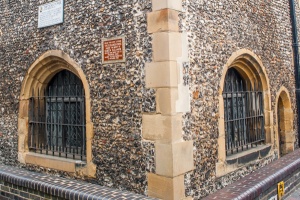
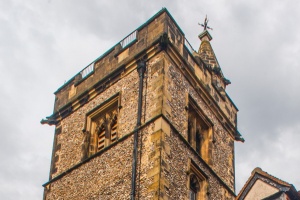
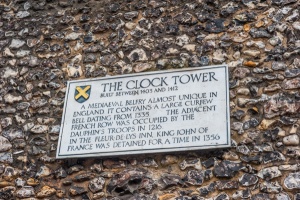
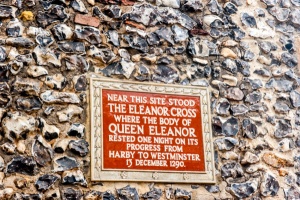
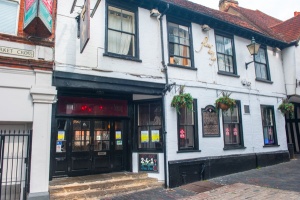
where King John was held
About St Albans Clock Tower
Address: Market Place, High Street, St Albans,
Hertfordshire,
England, AL3 4EL
Attraction Type: Historic Building
Location: On the Market Place, a short stroll from the cathedral. Numerous paid parking areas nearby. Nearest postcode (for satnav) is AL3 5DR
Website: St Albans Clock Tower
Location
map
OS: TL146071
Photo Credit: David Ross and Britain Express
HERITAGE
 We've 'tagged' this attraction information to help you find related historic attractions and learn more about major time periods mentioned.
We've 'tagged' this attraction information to help you find related historic attractions and learn more about major time periods mentioned.
Find other attractions tagged with:
NEARBY HISTORIC ATTRACTIONS
Heritage Rated from 1- 5 (low to exceptional) on historic interest
St Albans Cathedral - 0.1 miles (Cathedral) ![]()
St Albans Abbey Gateway - 0.2 miles (Historic Building) ![]()
St Albans, St Peter's Church - 0.4 miles (Historic Church) ![]()
St Albans South Signal Box and Railway Museum - 0.5 miles (Museum) ![]()
Sopwell Nunnery - 0.6 miles (Abbey) ![]()
Verulamium Museum - 0.6 miles (Roman Site) ![]()
Verulamium Hypocaust and Mosaic - 0.7 miles (Roman Site) ![]()
St Albans, St Michael's Church - 0.7 miles (Historic Church) ![]()
Nearest Holiday Cottages to St Albans Clock Tower:
Holmer Green, Buckinghamshire
Sleeps: 8
Stay from: £2188 - 9307
Bletchley, Buckinghamshire
Sleeps: 6
Stay from: £861 - 2487
More self catering near St Albans Clock Tower



